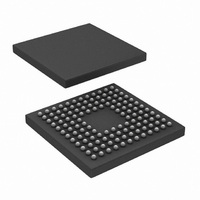CLC5903SM/NOPB National Semiconductor, CLC5903SM/NOPB Datasheet - Page 15

CLC5903SM/NOPB
Manufacturer Part Number
CLC5903SM/NOPB
Description
IC DGTL TUNER/AGC DUAL 128-FBGA
Manufacturer
National Semiconductor
Type
Tunerr
Datasheet
1.CLC5903SMNOPB.pdf
(29 pages)
Specifications of CLC5903SM/NOPB
Applications
Base Stations
Mounting Type
Surface Mount
Package / Case
128-FBGA
Lead Free Status / RoHS Status
Lead free / RoHS Compliant
Other names
*CLC5903SM
*CLC5903SM/NOPB
CLC5903SM
*CLC5903SM/NOPB
CLC5903SM
Available stocks
Company
Part Number
Manufacturer
Quantity
Price
Company:
Part Number:
CLC5903SM/NOPB
Manufacturer:
Texas Instruments
Quantity:
10 000
Detailed Description
mum headroom through the CIC filter. For optimal noise per-
formance the SCALE value is set to increase this level until
the CIC filter is just below the point of distortion. A value is
normally calculated and loaded for SCALE such that
filter will only be unity for power-of-two decimation values. In
other cases the gain will be somewhat less than unity.
Channel Gain
The gain of each channel can be boosted up to 42 dB by
shifting the output of the CIC filter up by 0 to 7 bits prior to
rounding it to 21 bits. For channel A, the gain of this stage is:
flow due to the GAIN circuit is saturated (clipped) at plus or
minus full scale. Each channel can be given its own GAIN
setting.
First Programmable FIR Filter (F1)
The CIC/GAIN outputs are followed by two stages of filtering.
The first stage is a 21 tap decimate-by-2 symmetric FIR filter
with programmable coefficients. Typically, this filter compen-
sates for a slight droop induced by the CIC filter while remov-
ing undesired alias images above Nyquist. In addition, it
often provides stopband assistance to F2 when deep stop
bands are required. The filter coefficients are 16-bit 2’s com-
plement numbers. Unity gain will be achieved through the fil-
ter if the sum of the 21 coefficients is equal to 2
is not 2
ficients)/2
coefficients are symmetric, so only the first 11 are loaded
into the chip.
Two example sets of coefficients are provided here. The first
set of coefficients, referred to as the standard set (STD),
compensates for the droop of the CIC filter providing a pass-
band which is flat (0.01 dB ripple) over 95% of the final out-
put bandwidth with 70dB of out-of-band rejection (see Figure
21). The filter has a gain of 0.999 and is symmetric with the
following 11 unique taps (1|21, 2|20, ..., 10|12, 11):
GAIN
GAIN
h
1
n
−100
−10
−20
−30
−40
−50
−60
−70
−80
−90
,
SHIFTUP
0
=
16
0
n
2
, then F1 will introduce a gain equal to (sum of coef-
29, -85, -308, -56, 1068, 1405, -2056, -6009,
1303, 21121, 32703
16
Figure 21. F1 STD frequency response
GAIN_A
=
. The 21 coefficients are identified as coefficients
0
,
Frequency Normalized To Filter Input Sample Rate
0.1
GAIN
, where GAIN_A ranges from 0 to 7. Over-
,
Frequency Response of F1 Using STD Set
20
CIC
where
0.2
1
h
. The actual gain of the CIC
1
10
(Continued)
0.3
is the center tap. The
0.4
16
. If the sum
0.5
15
The second set of coefficients (GSM set) are intended for
applications that need deeper stop bands or need oversam-
pled outputs. These requirements are common in cellular
systems where out of band rejection requirements can
exceed 100dB (see Figure 22). They are useful for wideband
radio architectures where the channelization is done after the
ADC. These filter coefficients introduce a gain of 0.984 and
are:
Second Programmable FIR Filter (F2)
The second stage decimate by two or four filter also uses
externally downloaded filter coefficients. F2 determines the
final channel filter response. The filter coefficients are 16-bit
2’s complement numbers. Unity gain will be achieved through
the filter if the sum of the 63 coefficients is equal to 2
sum is not 2
(sum of coefficients)/2
The 63 coefficients are identified as
where
metric, so only the first 32 are loaded into the chip.
An example filter (STD F2 coefficients, see Figure 23) with
80dB out-of-band rejection, gain of 1.00, and 0.03 dB peak to
peak passband ripple is created by this set of 32 unique
coefficients:
A second set of F2 coefficients (GSM set, see Figure 24)
suitable for meeting the stringent wideband GSM require-
ments with a gain of 0.999 are:
The filter coefficients of both filters can be used to tailor the
spectral response to the user’s needs. For example, the first
can be loaded with the standard set to provide a flat
−100
−120
−20
−40
−60
−80
0
h
0
2
Figure 22. F1 GSM frequency response
-49, -340, -1008, -1617, -1269, 425, 3027, 6030,
9115, 11620, 12606
-14, -20, 19, 73, 43, -70, -82, 84, 171, -49, -269,
-34, 374, 192, -449,
-430, 460,751, -357, -1144, 81, 1581, 443, -2026,
-1337, 2437, 2886,
-2770, -6127, 2987, 20544, 29647
-536, -986, 42, 962, 869, 225, 141, 93, -280,
-708, -774, -579, -384,
-79, 536, 1056, 1152, 1067, 789, 32, -935, -1668,
-2104, -2137, -1444,
71, 2130, 4450, 6884, 9053, 10413, 10832
31
16
, then the F2 will introduce a gain equal to
Frequency Normalized To Filter Input Sample Rate
is the center tap. The coefficients are sym-
0.1
Frequency Response of F1 Using GSM Set
16
.
0.2
0.3
h
2
n
,
0.4
n
www.national.com
=
0
16
,
. If the
0.5
,
62











